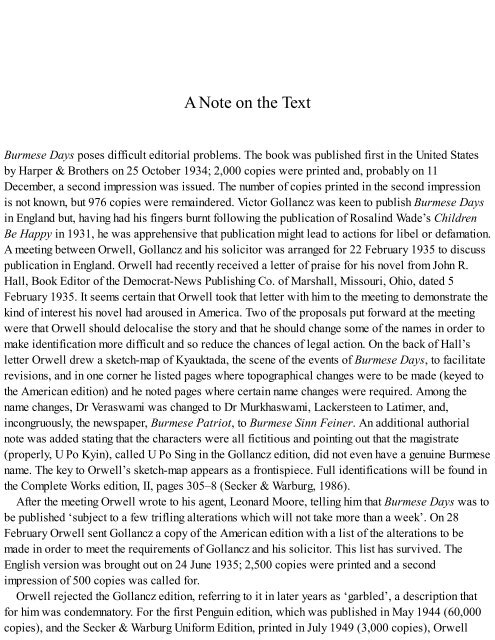563296589345
Create successful ePaper yourself
Turn your PDF publications into a flip-book with our unique Google optimized e-Paper software.
A Note on the Text<br />
Burmese Days poses difficult editorial problems. The book was published first in the United States<br />
by Harper & Brothers on 25 October 1934; 2,000 copies were printed and, probably on 11<br />
December, a second impression was issued. The number of copies printed in the second impression<br />
is not known, but 976 copies were remaindered. Victor Gollancz was keen to publish Burmese Days<br />
in England but, having had his fingers burnt following the publication of Rosalind Wade’s Children<br />
Be Happy in 1931, he was apprehensive that publication might lead to actions for libel or defamation.<br />
A meeting between Orwell, Gollancz and his solicitor was arranged for 22 February 1935 to discuss<br />
publication in England. Orwell had recently received a letter of praise for his novel from John R.<br />
Hall, Book Editor of the Democrat-News Publishing Co. of Marshall, Missouri, Ohio, dated 5<br />
February 1935. It seems certain that Orwell took that letter with him to the meeting to demonstrate the<br />
kind of interest his novel had aroused in America. Two of the proposals put forward at the meeting<br />
were that Orwell should delocalise the story and that he should change some of the names in order to<br />
make identification more difficult and so reduce the chances of legal action. On the back of Hall’s<br />
letter Orwell drew a sketch-map of Kyauktada, the scene of the events of Burmese Days, to facilitate<br />
revisions, and in one corner he listed pages where topographical changes were to be made (keyed to<br />
the American edition) and he noted pages where certain name changes were required. Among the<br />
name changes, Dr Veraswami was changed to Dr Murkhaswami, Lackersteen to Latimer, and,<br />
incongruously, the newspaper, Burmese Patriot, to Burmese Sinn Feiner. An additional authorial<br />
note was added stating that the characters were all fictitious and pointing out that the magistrate<br />
(properly, U Po Kyin), called U Po Sing in the Gollancz edition, did not even have a genuine Burmese<br />
name. The key to Orwell’s sketch-map appears as a frontispiece. Full identifications will be found in<br />
the Complete Works edition, II, pages 305–8 (Secker & Warburg, 1986).<br />
After the meeting Orwell wrote to his agent, Leonard Moore, telling him that Burmese Days was to<br />
be published ‘subject to a few trifling alterations which will not take more than a week’. On 28<br />
February Orwell sent Gollancz a copy of the American edition with a list of the alterations to be<br />
made in order to meet the requirements of Gollancz and his solicitor. This list has survived. The<br />
English version was brought out on 24 June 1935; 2,500 copies were printed and a second<br />
impression of 500 copies was called for.<br />
Orwell rejected the Gollancz edition, referring to it in later years as ‘garbled’, a description that<br />
for him was condemnatory. For the first Penguin edition, which was published in May 1944 (60,000<br />
copies), and the Secker & Warburg Uniform Edition, printed in July 1949 (3,000 copies), Orwell









![Genki - An Integrated Course in Elementary Japanese II [Second Edition] (2011), WITH PDF BOOKMARKS!](https://img.yumpu.com/58322134/1/180x260/genki-an-integrated-course-in-elementary-japanese-ii-second-edition-2011-with-pdf-bookmarks.jpg?quality=85)
![Genki - An Integrated Course in Elementary Japanese I [Second Edition] (2011), WITH PDF BOOKMARKS!](https://img.yumpu.com/58322120/1/182x260/genki-an-integrated-course-in-elementary-japanese-i-second-edition-2011-with-pdf-bookmarks.jpg?quality=85)





